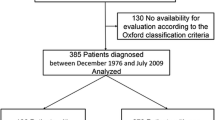Abstract
Since isolated C3 mesangial proliferative glomerulonephritis in the absence of systemic disease (i-C3-GN) is an uncommon chronic glomerular disease, long-term prognosis and optimal therapeutic intervention for it are not yet fully defined, especially in children. We report clinical features, outcome, and interventions in 4 patients, ranging from 6 to 18 years old, with i-C3-GN. Microscopic or macroscopic hematuria with or without proteinuria was first noted between 3 and 8 years. When present, proteinuria ranged from 0.2 to 1.0 g/24 h. Persistent hypocomplementemia and circulating immune complexes were found in 1 patient. None of the patients had nephrotic syndrome or hypertension. Percutaneous renal biopsy specimens showed varying degrees of mesangial proliferative glomerulonephritis; 2 patients showed mild mesangial proliferation, while others exhibited moderate histologic severity. In 1 patient with a mild mesangial increase, tubulointerstitial changes were associated. Both patients exhibiting mild mesangial changes followed a benign clinical course with normal renal function over 10 years of follow-up. Patients with moderately severe mesangial alteration manifested slight renal function loss and moderate proteinuria at the time of biopsy, but these largely resolved after a six-month course of prednisolone combined with cyclophosphamide, warfarin, and an angiotensin-converting enzyme inhibitor. Thus, clinical manifestations and the need for aggressive treatment appear to vary among pediatric patients with i-C3-GN. Therapy combining prednisolone with immunosuppression seemed to reduce proteinuria and improve glomerular function in patients with moderately severe mesangial proliferation.




Similar content being viewed by others
References
Orfila C, Periaggi M-Th, Suc J-M (1980) Mesangial isolated C3 deposition in patients with recurrent or persistent hematuria. Lab Invest 43:1–8
Grekas D, Morley AR, Wilkinson R, Kerr DNS (1984) Isolated C3 deposition in patients without systemic diseases. Clin Nephrol 21:270–274
Ginesta JC, Almirall J, Torras A, Darnell A, Revert L (1995) Long-term evoluation of patients with isolated C3 mesangial glomerulonephritis. Clin Nephrol 43:221–225
Larsen S (1978) Immunofluorescent microscopy findings in minimal or no change disease and slight mesangioproliferative glomerulonephritis. Acta Pathol Microbiol Scand A 86:531
Manno C, Proscia AR, Laraia E, Giangrande M, Di Carlo M, Salvatore C (1990) Clinicopathological features in patients with isolated C3 mesangial proliferative glomerulonephritis. Nephrol Dial Transplant Suppl 1:78–80
Verroust PJ, Wilson CB, Cooper NR, Edgington TS, Dixon FJ (1974) Glomerular complement components in human glomerulonephritis. J Clin Invest 53:77–81
Kusumoto Y, Takebayashi S, Taguchi T, Harada T, Naito S (1987) Long-term prognosis and prognostic indices of IgA nephropathy in juvenile and adult Japanese. Clin Nephrol 28: 118–124
Wyatt R, Kritchevsky S, Woodford S, Miller P, Roy SI, Holland N, Jackson E, Bishof N (1995) IgA nephropathy: long-term prognosis for pediatric patients. J Pediatr 127: 913–919
Hoggs R, Silva F, Wyatt R, Reisch J, Argyle J, Savino D (1994) Prognostic indicators in children with IgA nephropathy—a report from the Southwest Pediatric Nephrology Study Group. Pediatr Nephrol 8:15–20
Yagi K, Okada M, Yanagida H, Kuwajima H, Ikeda M, Sugimoto K, Takemura T (2003) Comparison of antiproteinuric effects of two defferent combination therapies in children with IgA nephropathy. Clin Exp Nephrol 7:270–274
Matsusaka T, Hymes J, Ichikawa I (1996) Angiotensin in progressive renal disease. Theory and practice. J Am Soc Nephrol 7:2025–2043
Maschio G, Alberti D, Janin G, Locatelli F, Mann JFE, Motolese M, Ponticelli C, Ritz E, Zucchelli P (1996) Effect of the angiotensin-converting enzyme inhibitor therapy on the progression of the chronic renal insufficiency. N Eng J Med 334:939–945
Dimitrova V, Minkova V, Belovezhdov N (1991) Mesangial C3 glomerulonephritis. Vutr Boles 30:47–50
Grcevska L, Polenakovic M (1998) Long-term follow-up of patients with isolated C3 nephritis. Clin Nephrol 50:269–270
Shin ML, Gelfand MC, Nagle RB, Carlo JR, Green I, Frank MM (1977) Localization of receptors for activated complement on visceral epithelial cells of the human renal glomerulus. J Immunol 118:869–873
Doi T, Kanatsu K, Suehiro F, Nagai H, Yoshida H, Hamashima Y (1987) Clinicopathological study of patients with mesangial isolated C3d deposition in various glomerular diseases. Nephron 46:188–193
Acknowledgements
We are grateful to Ms. Naomi Jinno for preparation of the manuscript. This study was partly supported by a Grant-in-Aid for Scientific Research from the Japanese Ministry of Education (Japan) to T.T. (C: 15591144, 2003–2004).
Author information
Authors and Affiliations
Corresponding author
Rights and permissions
About this article
Cite this article
Yagi, K., Yanagida, H., Sugimoto, K. et al. Clinicopathologic features, outcome, and therapeutic interventions in four children with isolated C3 mesangial proliferative glomerulonephritis. Pediatr Nephrol 20, 1273–1278 (2005). https://doi.org/10.1007/s00467-005-1919-4
Received:
Revised:
Accepted:
Published:
Issue Date:
DOI: https://doi.org/10.1007/s00467-005-1919-4




